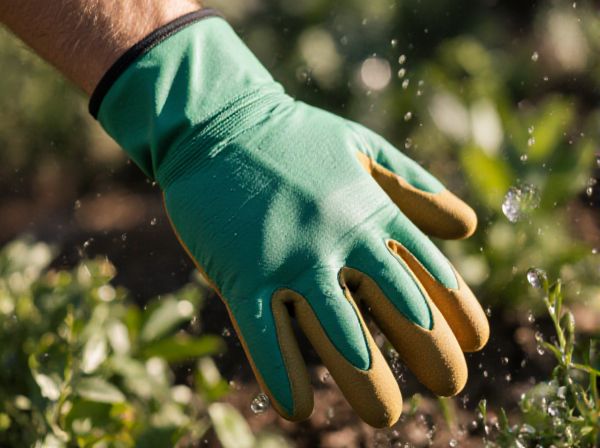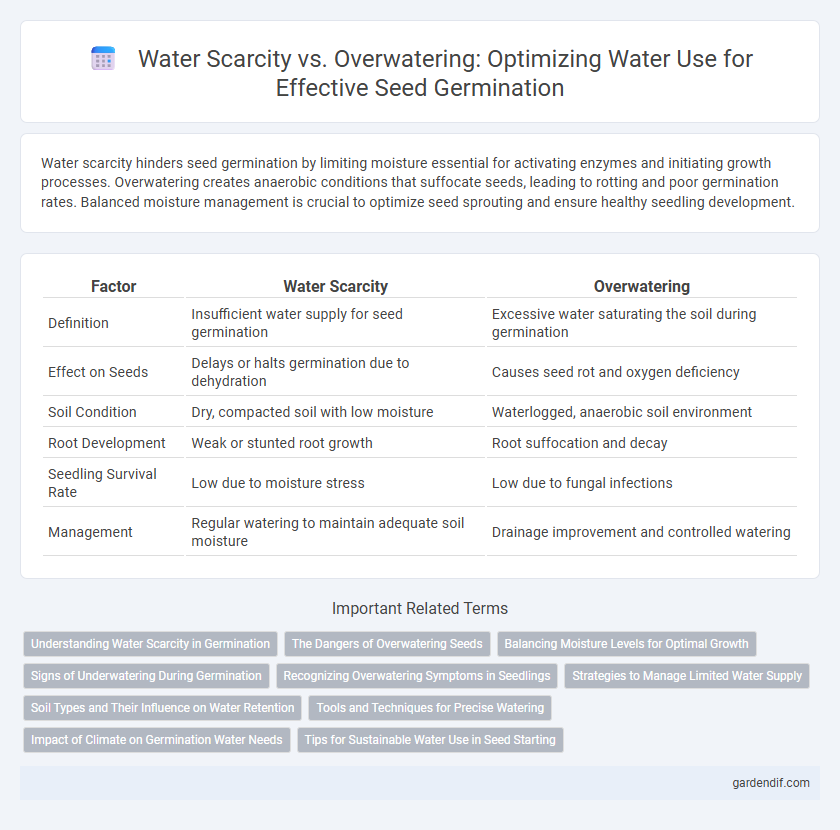
Water Scarcity vs Overwatering Illustration
Water scarcity hinders seed germination by limiting moisture essential for activating enzymes and initiating growth processes. Overwatering creates anaerobic conditions that suffocate seeds, leading to rotting and poor germination rates. Balanced moisture management is crucial to optimize seed sprouting and ensure healthy seedling development.
Table of Comparison
| Factor | Water Scarcity | Overwatering |
|---|---|---|
| Definition | Insufficient water supply for seed germination | Excessive water saturating the soil during germination |
| Effect on Seeds | Delays or halts germination due to dehydration | Causes seed rot and oxygen deficiency |
| Soil Condition | Dry, compacted soil with low moisture | Waterlogged, anaerobic soil environment |
| Root Development | Weak or stunted root growth | Root suffocation and decay |
| Seedling Survival Rate | Low due to moisture stress | Low due to fungal infections |
| Management | Regular watering to maintain adequate soil moisture | Drainage improvement and controlled watering |
Understanding Water Scarcity in Germination
Water scarcity during germination limits seed imbibition, slowing metabolic activation and reducing germination rates due to insufficient moisture for enzyme function. Seeds require a precise moisture threshold to trigger cellular processes, and inadequate water availability can lead to incomplete or delayed germination. Understanding the balance of soil moisture content is critical to prevent water stress while ensuring optimal hydration for seed development.
The Dangers of Overwatering Seeds
Excessive watering during germination leads to oxygen deprivation in seed cells, causing root rot and seed decay. Overwatering promotes fungal growth such as damping-off disease, which can devastate young seedlings before they establish. Maintaining balanced moisture is critical to ensure healthy seed development and avoid the detrimental effects of waterlogged soil.
Balancing Moisture Levels for Optimal Growth
Maintaining balanced soil moisture is crucial during germination, as water scarcity hinders seed activation and root development, while overwatering causes oxygen deprivation and root rot. Soil with optimal moisture content supports enzymatic activity and nutrient absorption, promoting uniform seedling emergence. Monitoring soil moisture with tools like tensiometers ensures consistent hydration without waterlogging, maximizing germination success rates.
Signs of Underwatering During Germination
Signs of underwatering during germination include slow or stalled seed sprouting, with seeds failing to break dormancy due to insufficient moisture. Seedlings may exhibit dry, brittle stems and leaves that curl or discolor early, indicating dehydration stress. Insufficient water disrupts enzymatic activity essential for germination, leading to weak or malformed seedlings vulnerable to transplant shock.
Recognizing Overwatering Symptoms in Seedlings
Seedlings experiencing overwatering exhibit symptoms such as yellowing leaves, wilting despite moist soil, and root rot caused by insufficient oxygen around roots. Waterlogged soil creates an anaerobic environment that hampers nutrient absorption and promotes fungal growth, severely impacting seedling development. Properly balanced moisture levels are essential to prevent these issues, ensuring healthy germination and robust seedling growth.
Strategies to Manage Limited Water Supply
Managing limited water supply during germination requires precise monitoring of soil moisture levels to avoid the detrimental effects of both water scarcity and overwatering. Employing drip irrigation systems and mulching techniques conserves water by reducing evaporation and directing moisture effectively to seeds. Selecting drought-resistant seed varieties and scheduling watering during cooler parts of the day further optimize water use efficiency in germination processes.
Soil Types and Their Influence on Water Retention
Soil types dramatically influence water retention during germination, with sandy soils draining quickly and often causing water scarcity, while clay soils retain excessive moisture leading to overwatering risks. Loamy soils balance water retention and drainage, creating optimal conditions for seed sprouting and root development. Understanding soil texture is crucial for adjusting watering practices to prevent germination failure due to either drought stress or root rot.
Tools and Techniques for Precise Watering
Utilizing soil moisture sensors and drip irrigation systems ensures precise watering during germination, preventing both water scarcity and overwatering. Automated timers combined with hygrometers optimize water delivery based on real-time soil and atmospheric conditions. These tools enhance seedling health and yield by maintaining consistent moisture levels tailored to specific seed requirements.
Impact of Climate on Germination Water Needs
Climate variability significantly influences germination water requirements, where water scarcity limits seed imbibition, delaying or preventing germination, while overwatering can cause oxygen deprivation, leading to seed rot and poor seedling development. In arid regions, seeds exhibit adaptive traits to minimize water loss and maximize uptake during rare precipitation events, ensuring successful germination under drought stress. Excessive rainfall or inefficient irrigation in humid climates increases soil moisture beyond optimal levels, creating anaerobic conditions that hinder cellular respiration necessary for seed germination.
Tips for Sustainable Water Use in Seed Starting
Efficient water management in seed germination involves using techniques such as bottom watering and moisture-retentive soil to prevent both water scarcity and overwatering. Employing a misting spray and monitoring soil moisture levels regularly ensures seeds receive adequate hydration without promoting fungal growth. Sustainable practices also include using recycled water when possible and mulching to reduce evaporation, maximizing water conservation during seed starting.
Water Scarcity vs Overwatering Infographic

 gardendif.com
gardendif.com